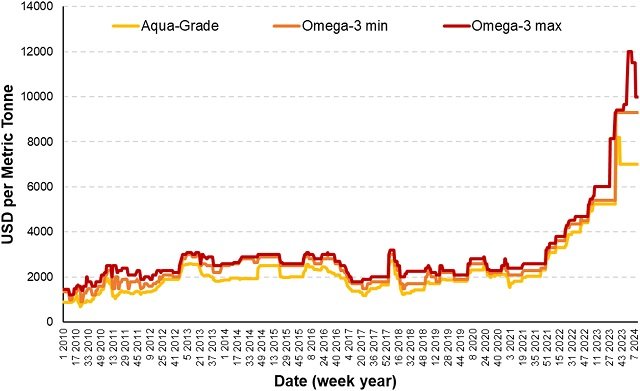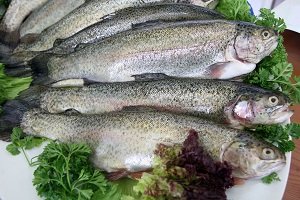
Aquaculturists worldwide are increasingly aware of the vital role that long-chain omega-3 polyunsaturated fatty acids (LC-PUFA) play in their stocks. These essential fats, particularly eicosapentaenoic acid (EPA) and docosahexaenoic acid (DHA), contribute to a variety of crucial physiological functions in many aquaculture species.
A scientific review led by Dr. Brett Glencross, along with a team of renowned human and fish nutrition experts from The Marine Ingredients Organisation (IFFO), the Institute of Aquaculture at the University of Stirling, the University of Southampton (UK), the Institute for Marine Research (Norway), and NOFIMA (Norway), assessed the current landscape of long-chain omega-3 polyunsaturated fatty acids (LC-PUFA), as well as their benefits, and explored their realistic growth potential. The report, published in Reviews of Fisheries Science and Aquaculture, is based on insights gained from a technical workshop held in Stirling, Scotland, in May 2023.
Beyond Growth: The Role of Omega-3s
While their impact on fish growth and meat quality is well-established, recent research underscores the importance of omega-3s in immune function, reproduction, bone formation, and stress response. This growing recognition highlights the critical need for a sustainable supply of LC-PUFA to meet the demands of a thriving aquaculture industry.
Fish Oil: The Current Source with Future Challenges
Currently, fish oil production remains the dominant source of LC-PUFA for aquaculture, utilizing a variety of fish species as raw material. However, concerns surrounding resource sustainability necessitate the exploration of alternative solutions.
Current estimates of EPA and DHA production are around 160,000 tons/year, of which more than 90% comes from fisheries and aquaculture resources:
- Global fish oil production estimates are around 1,200,000 tons/year, with a growing contribution from by-products of various fisheries and aquaculture (53%). Among these oils, EPA and DHA can account for anywhere from <2% to nearly 60% of total fatty acids.
- Aquaculture is a net producer of EPA + DHA relative to its inputs and a greater contributor to human EPA + DHA supplies than the direct consumption of wild fish.
“Among the aquaculture sectors that are the largest users of LC-PUFA resources (salmonids, shrimp, and marine fish), there are varying degrees of each sector’s capacity to synthesize LC-PUFA: this affects the extent to which they must be obtained through diet,” explains Glencross. Deficiency symptoms vary but often include reduced growth rate, poorer survival, and various pathologies.
Species-Specific Needs: Tailoring Diets for Optimal Health
The extent to which different aquaculture species require dietary LC-PUFA varies considerably. Salmonids, the largest consumers of these essential nutrients, possess some capacity to synthesize EPA and DHA internally. However, studies indicate significantly improved performance when they are provided preformed in their diet.
Shrimp present a more complex picture. Some species can convert short-chain fatty acids into LC-PUFA, while others depend entirely on a preformed dietary source. This diversity requires tailored feed formulations for optimal shrimp health.
Marine fish, on the other hand, have a limited capacity to desaturate and elongate precursor fatty acids, making them critically dependent on dietary LC-PUFA. Research conducted on numerous species reveals significant variations in their specific needs, with younger fish generally requiring higher levels than their adult counterparts. A “one-size-fits-all” approach simply does not apply.
Stay Always Informed
Join our communities to instantly receive the most important news, reports, and analysis from the aquaculture industry.
The Road Ahead: Exploring Sustainable Solutions
The prospects for expanding the volumes of available EPA and DHA are limited and include:
- Improvements in circular resource thinking. The scale of omega-3 polyunsaturated fatty acid losses through food waste alone is equivalent to approximately 50% of what is consumed. The model used by scientists in this review estimates a total set of 272,000 tons of EPA + DHA available from combined unused by-product resources.
- The development of other sources of these fatty acids, including those produced from zooplankton, algae, and genetically modified (GM) plants. So far, however, only algae oils contribute a significant volume, with an estimate of 12,000 tons for 2023.
“Much remains to be done to improve the understanding of the physiological functions of omega-3 LC-PUFA in aquaculture species and better define their needs for the large number of species currently being farmed in aquaculture,” says Glencross. For example, the previous nutritional history of an animal and how this affects subsequent requirement responses have yet to be examined. Additionally, dietary formulation strategies have changed significantly in recent decades and must be considered when determining the intake levels of all nutrients needed by fish. Finally, more research is needed to elucidate the multifaceted role that LC-PUFA are likely to play, including interactions among different PUFA.
Conclusion
“The capacity for further growth in the volumes of EPA and DHA from fishery resources seems limited, although the significant volumes now coming from fishery and aquaculture by-products bode well for attempts to create a greater circular economy for these nutrients. New sources are emerging, whether from algae or transgenic crops, and will become increasingly important resources in the future,” the scientists conclude.
Ensuring a sustainable supply of omega-3 LC-PUFA for aquaculture is crucial for both fish health and human nutrition. By understanding the specific needs of different species and exploring innovative and environmentally friendly alternatives, the aquaculture industry can be steered toward a healthy future.
Contact
Brett D. Glencrossa
IFFO, The Marine Ingredients Organisation,
London, UK
Email: bglencross@iffo.com
Reference (Open Access)
Glencross, B. D., Bachis, E., Betancor, M. B., Calder, P., Liland, N., Newton, R., & Ruyter, B. (2024). Omega-3 Futures in Aquaculture: Exploring the Supply and Demands for Long-Chain Omega-3 Essential Fatty Acids by Aquaculture Species. Reviews in Fisheries Science & Aquaculture, 1–50. https://doi.org/10.1080/23308249.2024.2388563
Note: The article was prepared with information from the scientific study and the press release “A new major study explores the supply and demand for Long-Chain Omega-3 Essential Fatty Acids.”
Editor at the digital magazine AquaHoy. He holds a degree in Aquaculture Biology from the National University of Santa (UNS) and a Master’s degree in Science and Innovation Management from the Polytechnic University of Valencia, with postgraduate diplomas in Business Innovation and Innovation Management. He possesses extensive experience in the aquaculture and fisheries sector, having led the Fisheries Innovation Unit of the National Program for Innovation in Fisheries and Aquaculture (PNIPA). He has served as a senior consultant in technology watch, an innovation project formulator and advisor, and a lecturer at UNS. He is a member of the Peruvian College of Biologists and was recognized by the World Aquaculture Society (WAS) in 2016 for his contribution to aquaculture.




